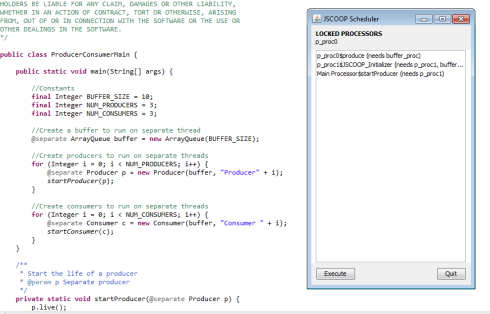SCOOP, or Simple Concurrent Object-Oriented Programming, is a model originally conceived for Eiffel to easily create parallel code. Eiffel has native support for rich types and pre-conditions, which has led to a design-by-contract paradigm in that programming language. The JSCOOP project that I am working on aims to bring the principles of design-by-contract and simple concurrency to Java.
The first thing we need to think about is the design-by-contract idea in Eiffel. How do we translate a model that builds off of this paradigm (explicit pre-conditions and post-conditions for any method)? JSCOOP takes it half of the way there by adding support for pre-conditions to any method. It looks like this:
@await(pre="!buffer.isEmpty()")
public String consume(@separate Buffer buffer) {
return buffer.take();
}
I’ll explain the separate annotation later, but let’s take a look at @await. Whenever this method is invoked, the system will enforce that the buffer is not empty before it allows the call to go through. Note that this does not mean that this method is called every time the buffer is empty. Note also that we haven’t gained any parallelism here, yet; we’ve just restricted ourselves.
Enter @separate. This simple keyword says, this is a reference to an object that runs on a different thread than this current code is running on (worth noting that it is certainly more complicated than that). When we execute a method on a separate object, we’re really telling that method to execute on the other thread, whenever it gets the chance to.
The concept of who executes these “remote” methods is called a Processor in JSCOOP. The processor has its own thread of execution and–most importantly–executes requests in the order that they are given. A processor can handle one or more objects. This means that we could have two separate Buffer objects both running on the same Processor, and thus only one of them would be executing at any given time.
Stepping back to consider this, we must understand then that the @separate annotation marks references that are potentially separate, rather than references that are definitely separate.
How does JSCOOP prevent concurrent access?
Consider a Producer-Consumer problem in which all Producers and Consumers share a reference to a common Buffer. Using the JSCOOP model, we store a @separate reference to the same Buffer in each of the Producer/Consumer instances. But surely when we run the Producers/Consumers on separate threads, we’ll concurrently modify the buffer, leading to classic problems.
We introduce the concept now of locking a Processor. Whenever a @separate reference is declared as the parameter of a function (as in the consume example above), we lock the Processor that owns the object referenced in the parameter. Locking a processor says, “only I can add remote calls to this processor’s queue”. What it means is that we’re not actually executing buffer.take() immediately; we’re putting it onto the run queue of buffer’s Processor (its handler). In this case, we require the result of buffer.take(), so we must wait for the call to finish, but that isn’t always the case (this concept called wait-by-necessity). After adding all of the calls in the method to the queue, and waiting for whichever ones we require, we can unlock the processor, allowing other methods that need it (read: have a @separate parameter whose reference is handled by the same Processor) to have their requests go through.
Thus, concurrent access is prevented in the Processor. Because it has a run queue, it waits to execute the next method when it can, according to locking and pre-conditions. This is guaranteed to be safe because each object has only one handling Processor.
That’s all for now
There’s a lot more to the system, but the above serves as a good first step for programmers familiar with concurrency issues in understanding how to program with JSCOOP. Specifically, there is a Scheduler for the entire system that I haven’t mentioned; this checks preconditions, manages Processors, and ensures fairness.


